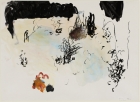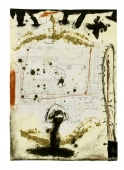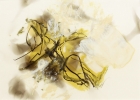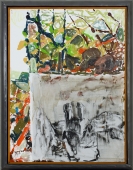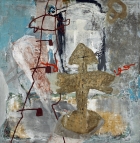
Artist | Stefan Heyne (*1965)
https://www.artist-info.com/artist/Stefan-Heyne
Biography
Biography
1965 born in Brandenburg/Havel, Deutschland
1987-92 Kunsthochschule Berlin(Prof. Volker Pfüller)
1993 Masters Degree Award
lives and works in Berlin
Solo Exhibitions (selection)
Solo Exhibitions (selection)
2006 “TATORTE“, Galerie Blickensdorff, Berlin
2005 „NACHTWACHE“, Sächsisches Staatsministerium der Finanzen, Dresden
2005 „FAHRTENSCHREIBER“, Brotfabrik Galerie, Berlin (with catalogue
2004 „TATORTE“ Galerie Blickensdorff, Berlin
Group Exhibitions (selection)
Group Exhibitions (selection)
2004 „Wo liegt Berlin? Fotografische Annäherungen an eine Stadt“ mit E. Bertram, R. Miyamoto, G.+H. Nothelfer u.a., Brotfabrik Galerie, Berlin (with catalogue)
Bibliography
Bibliography
2006 “Nachtrag zur Melancholie” by Christian Hufen in kunst-blog.com
2005 "Stefan Heyne", Salon-Verlag, Köln (with textes by Christoph Tannert and Prof. Gerhard Gamm and edition)
2005 “Erziehung zur Unschärfe”, Stefan Heyne im Interview mit Petra Schröck
2005 „Magie der Leere“, Irene Bazinger, in Berliner Zeitung, Feuilleton, Datum
Public and Private Collections
Public and Private Collections
Works in private collections in Germany and USA
Stage Design
Stage Design
For Hamburgsiche Staatsoper, Volksbühne Berlin, Deutsches Theater Berlin
About the work (English / Deutsch)
About the work (English / Deutsch)
Indications of What is Not Obvious
Is someone here incapable of focusing his lens? The fog of color that rules in Stefan Heyne’s photographs and that makes spaces and fragments of objects sink into the approximation of impression raises some questions. Questions of the relationship between optics and the psychology of perception, of the learning of legibility, of the dialog between photography and painting: in brief, of the perception of the picture.
With Stefan Heyne, it seems to me as if the eye were coerced into watching itself seeing. One could speak of a doubled perception, of what one has before one’s (rain-veiled) eyes and of what the imagination is to achieve. The effect depends on this process of assimilation. Behind it is the search for an art for which commentary and conceptual considerations seem as important as what meets the eye. This kind of coercion of perception and of reading the image places accents in the direction of the unexpected.
In the rulebook of modernism, intersections between photography and painting are as old as the medium itself. What is surprising is how Heyne responds with painterly soft-focus effects to the cool, downright mint-fresh pop productions of glossy surfaces with which current representational painting tries to maintain its catchy tone and its compatibility with the entertainment culture.
Stefan Heyne stands more on the other side, in the ranks of Anti-Pop, for he does not develop and animate the smudge-free production of surfaces, he experiments with it. He simulates smoothness, only to break through the slickness with distancing cloudiness. His impulse to buffer is connected with nothing else than turning off his camera’s automatic focus. These are contours of softening, increasingly abstract commentaries to expose cynicism and the armaments of fun.
Such a strategy gives rise to pictures that make some people feel good, while others see it as nothing but the production of illusion. That is why the line Stefan Heyne tries to balance along is narrow. But let it be clear: Heyne is not a representative of photographic Impressionism. He does not invoke the reproduction of mere moods any more than he is interested in the relation to documentation or the topicality of the television image.
He has made it his task to seek possibilities to give visibility to the perception of space and to let visual spaces arise through the composition of situations of light and surfaces. He counters the recent “bonjour tristesse” in the sense of subjective interpretation of the world by blurring motif and object and rejecting the expectation that the motif could contain concealed meanings.
Heyne uses the lens of his CANON 10D reflex camera to adjust “unfocuses”. The only digital retouching he undertakes is to “spot” the pictures. He does entirely without pictorial supplementations and interventions. When, as in “Painting” (2004), he eliminates color from the picture, then only for the sake of reversing or clarifying from positive to negative image.
Heyne’s view of reality is made visible in fuzziness, in the way that, with the relativizing of the visible, one’s own groping in space for what is not obvious, for the mysterious and ephemeral, becomes an occasion for producing pictures.
Heyne also clarifies anew that photography, despite all appearances, is completely unsuited to conveying precise information. The only clear statement of which it might be capable is to say: I am a photograph – and not a painting... Of course, Heyne immediately defeats it again with its own weapons on his compositional stage of ambivalences.
Text by Christoph Tannert
Hinweise auf das Nichtoffenkundige
Kann hier jemand seine Linse nicht scharfstellen? Der Farbnebel, der in den Fotografien von Stefan Heyne herrscht und Räume und Gegenstandsfragmente in das Ungefähre der Impression versinken läßt, wirft Fragen auf. Fragen nach dem Verhältnis von Optik und Wahrnehmungspsychologie, dem Erlernen von Lesbarkeit, dem Dialog von Fotografie und Malerei – kurz: nach der Wahrnehmung des Bildes.
Bei Stefan Heyne kommt es mir vor, als werde das Auge dazu genötigt, sich selbst beim Sehen zuzusehen. Von einem doppelten Wahrnehmen könnte man reden, von dem, was man (regenverhangen) vor Augen hat, und von dem, was die Vorstellung zustande bringen soll. Die Wirkung ist auf diesen Assimilationsprozeß angewiesen. Dahinter steckt die Suche nach einer Kunst, für die Kommentar und konzeptuelle Überlegungen ebenso wichtig erscheinen wie das, was vor Augen tritt. Eine derartige Nötigung von Perzeption und Bildlektüre setzt Akzente in Richtung des Unerwarteten.
Überschneidungen zwischen Fotografie und Malerei im Regelwerk der Moderne sind so alt wie das Medium selbst. Überraschend ist, wie Heyne mit malerischen Weichzeichnereffekten auf die kühle, geradezu minzefrische Pop-Produktion der glatten Oberflächen reagiert, mit dem die aktuelle gegenständliche Malerei ihren eingängigen Ton und ihre Kompatibilität mit der Amüsierkultur zu halten sucht.
Stefan Heyne steht eher auf der anderen Seite, in den Reihen des Anti-Pop, denn er entwickelt und animiert nicht die schmutzfreie Oberflächenproduktion, er experimentiert mit ihr. Er simuliert Glätte, um mit distanzierenden Wolkigkeiten die Gelecktheit zu durchbrechen. Sein Abpufferungsimpuls ist mit nichts als dem ausgeschalteten Autofokus seiner Kamera verbunden. Es sind Konturen aufweichende, zunehmend abstrakte Kommentare zur Entlarvung des Zynismus und der Spaßbewaffnung.
Eine solche Strategie läßt Bilder entstehen, die dem einen Wohlbehagen bereiten, dem anderen nichts weiter sind als eine Illusionsproduktion. Deswegen ist der Grad schmal, auf dem Stefan Heyne balanciert. Wobei klargestellt sei: Heyne ist kein Vertreter eines fotografischen Impressionismus. Er beruft sich so wenig auf die Wiedergabe bloßer Stimmungen wie ihn der Bezug zum Dokumentarischen oder der Aktualität des Fernsehbildes interessiert.
Er hat es sich zur Aufgabe gemacht, nach Möglichkeiten der Visualisierung von Raumwahrnehmung zu suchen, Bildräume über die Komposition von Licht- und Flächenverhältnissen entstehen zu lassen. Dem neuerlichen „bonjour tristesse“ im Sinne subjektiver Weltdeutung setzt er die Verwischung von Motiv und Gegenstand und eine Absage an die Erwartung, das Motiv könnte versteckte Bedeutungen enthalten, entgegen.
Heyne nutzt das Kameraobjektiv seiner CANON 10D Spiegelreflex, um Unschärfen einzustellen. Digitale Retuschen nimmt er lediglich vor, wenn es an‘s „Ausflecken“ geht. Auf bildnerische Ergänzungen oder Interventionen verzichtet er gänzlich. Wenn er, wie in „Painting“ (2004) Farbe aus dem Bild eliminiert, dann lediglich, um der Umkehrung bzw, Klärung vom Positiv zum Negativ wegen.
In der Unschärfe verbildlicht sich Heynes Sicht auf die Wirklichkeit, in der mit der Relativierung des Sichtbaren das eigene Tasten im Raum nach dem Nichtoffenkundigen, Geheimnisvollen, Flüchtigen zum Anlass der Bildproduktion wird.
Außerdem stellt Heyne erneut klar, daß die Fotografie, allem Anschein zum Trotz, völlig ungeeignet ist, präzise Informationen zu übermitteln. Die einzige klare Aussage, derer sie fähig sein sollte, wäre die, zu sagen: Ich bin eine Fotografie – und kein Gemälde… Freilich schlägt Heyne sie an dieser Stelle gleich wieder mit ihren eigenen Waffen auf seiner kompositorischen Bühne der Ambivalenzen.
Text by Christoph Tannert
Internet
Internet
 offers / Requests offers / Requests  |
About this service |
|---|
 Exhibition Announcements Exhibition Announcements  |
About this service |
|---|
 Visualization |
Learn more about this service | ||
|---|---|---|---|

Interested in discovering more of this artist's networks?
3 easy steps: Register, buy a package for a visualization, select the artist.
See examples how visualization looks like for an artist, a curator, or an exhibition place: Gallery, museum, non-profit place, or collector.

Exhibition History

|
SUMMARY based on artist-info records. More details and Visualizing Art Networks on demand. Venue types: Gallery / Museum / Non-Profit / Collector |
||||||||||||
| Exhibitions in artist-info | 5 (S 3/ G 2) |
Did show together with - Top 5 of 11 artists (no. of shows) - all shows - Top 100
|
||||||||||
| Exhibitions by type | 5: 4 / 1 / 0 / 0 | |||||||||||
| Venues by type | 3: 2 / 1 / 0 / 0 | |||||||||||
| Curators | 0 | |||||||||||
| artist-info records | Dec 2004 - Jul 2016 | |||||||||||
|
Countries - Top 1 of 1 Germany (3) |
Cities 3 - Top of 3 Köln (2) Berlin (2) Bochum (1) |
Venues (no. of shows )
Top 3 of 3
|
||||||||||
|
Curators (no. of shows)
Top 0 of 0 |
| Kunstmuseum Bochum | G | May 2016 - Jul 2016 | Bochum | (122) | +0 | |
| Kaune, Sudendorf — Gallery for contemporary photography | G | Sep 2009 - Oct 2009 | Köln | (12) | +0 | |
| Kaune, Sudendorf — Gallery for contemporary photography | S | May 2009 - Jul 2009 | Köln | (12) | +0 | |
| Galerie Blickensdorff | S | Apr 2006 - Jun 2006 | Berlin (Mitte) | (49) | +0 | |
| Galerie Blickensdorff | S | Dec 2004 - Feb 2005 | Berlin (Mitte) | (49) | +0 | |
| Keep reading |




















